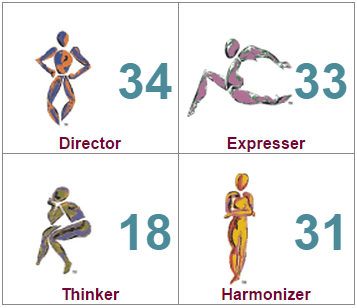
“I know all but myself.” – Francois Villon (1431-1465)
 In file cabinets, photo albums, mobile phones, and desk drawers, most of us have more photographs of ourselves than we will ever have time to sort through. Even if we did, these pictures wouldn’t reveal all we wish we could know. They might remind us that our closest friend in childhood was the family dog. They might help us recall our first athletic exploits. But those flat, two-dimensional images can hardly tell the full story of who we are or how we relate to other people.
In file cabinets, photo albums, mobile phones, and desk drawers, most of us have more photographs of ourselves than we will ever have time to sort through. Even if we did, these pictures wouldn’t reveal all we wish we could know. They might remind us that our closest friend in childhood was the family dog. They might help us recall our first athletic exploits. But those flat, two-dimensional images can hardly tell the full story of who we are or how we relate to other people.
The first section of the Straight Talk book – and the survey that goes with it – is a sort of 3-D camera, one that captures a multi-dimensional snapshot of yourself. It enables you to see yourself as others see you. It reveals your particular style of communicating. And it will help you become a more successful communicator.
 When people first discover their styles, it’s an epiphany. People turn to each other and say: “So that’s why you love details!” Or: “Now I see why you and I get along so well!” People will spend hours talking about the insights they’ve gained. It’s not unusual to see people huddled together, comparing their styles and saying, “If only I knew this when….”
When people first discover their styles, it’s an epiphany. People turn to each other and say: “So that’s why you love details!” Or: “Now I see why you and I get along so well!” People will spend hours talking about the insights they’ve gained. It’s not unusual to see people huddled together, comparing their styles and saying, “If only I knew this when….”
One organization, a New York magazine publisher, took it a step further. The president had baseball caps made for everyone, a different color hat for each communication style. We found the place swarming with green, red, yellow and orange hats. On each hat was inscribed: “It’s all a matter of style.”
Reactions like these are typical. They typify the excitement that comes with learning about communication styles. But along with the excitement comes a long list of benefits. You’ll learn more about these as we go along. If you want to become a skilled communicator, this is the place to start.
Think for a moment about people with whom you communicate easily and naturally. They are like your second self. You see things the same way they do. You share their thoughts and feelings – you can complete their sentences. Even when you have a dispute, you know they see your side of the story, just as you see theirs.
 Some people, on the other hand, are on a different wave length. They never see things the same things you do. They don’t tackle problems in the same way. Maybe you think there’s something wrong with your relationship. Most likely not. More likely, it’s merely a matter of style.
Some people, on the other hand, are on a different wave length. They never see things the same things you do. They don’t tackle problems in the same way. Maybe you think there’s something wrong with your relationship. Most likely not. More likely, it’s merely a matter of style.
Research shows that people communicate in measurably different ways. These differences reflect differences in what we choose to hear and say. Some people focus on feelings. Some people focus on tasks. Some focus on the big picture. Some focus on the smallest details.
These choices determine how we relate to the world. So understanding our style is tantamount to understanding how we see the world around us.
In a sense, our world is a reflection of our style.
Communication styles are a manifestation of our personalities. But they are not the same as personality. Scholars and researchers agree that personality is relatively stable, changing only subtly over time. Our style of communicating, on the other hand, is a learned behavior. We can modify it once we learn how. In fact, skilled communicators can modify their style on the spot, as the situation warrants. Just like reading a book, hitting a baseball, or diving into a pool, modifying your style is a skill. It doesn’t come naturally. But once you learn, it’s a skill you can use all your life.
After all, shouldn’t you be content to be who you are? That’s a reasonable argument. But your world consists of many different types of people –colleagues, bosses, employees and customers – and it’s to your advantage to understand exactly where they’re coming from.
At the same time, people have a basic need to feel understood, to feel listened to. When people perceive you as a competent communicator, when they know you understand their thoughts and feelings, something magical happens. People begin to look to you for leadership. They pay more attention to you, knowing that you respect them. There’s a bonus that comes with understanding communication styles: It elevates all your relationships to a higher plane.
 For managers and leaders, understanding communication styles is an indispensable skill. It enables you to translate differences in what people say. It enables you to mediate conflicts. It paves the way for successful discussions about complex subjects. It’s a truism that leaders and managers must be good communicators.
For managers and leaders, understanding communication styles is an indispensable skill. It enables you to translate differences in what people say. It enables you to mediate conflicts. It paves the way for successful discussions about complex subjects. It’s a truism that leaders and managers must be good communicators.
But there’s a difference between being articulate, which is what books about communication typically teach, and knowing the tools of straight talk.
Understanding your style of communicating would be relatively easy if you limited yourself to one of the four basic styles. However, depending on the situation, you may alternate between one, two, or even three styles. It’s like walking. You naturally walk at a certain pace. But then you shift gears to match the pace of someone next to you.
It’s the same with communicating. People prefer to use one style. Our “primary style” is the one we’re most comfortable with. But we also have a backup style. Typically, this second style is dictated by our situation — the demands of our particular job if at work, the demands of domestic life if at home.
We refer to the backup style as our “secondary style.” Most people vacillate frequently between their primary and secondary styles. As a result, our overall or specific style becomes a combination of these two styles. It’s like mixing lemon into tea: The concoction has a flavor all its own.
Here are three useful posts on identifying other people’s communication styles:
Or learn more about these in our free Video Series on Communication Styles.
By training yourself to identify and understand each style, you’ll quickly learn to appreciate some of the subtleties in people’s communications — the hidden meanings behind their words, the types of things they pay attention to. This, in turn, will lead to more satisfying and more successful interactions.
Learning to identify another person’s prevailing styles without relying on the Communication Styles Profile is a key still in becoming a competent communicator. As your skill and confidence grow, you’ll discover that you’ll quickly be able to determine the two communication styles others use more frequently.
Once you understand how your style differs from another person’s, you can see how you might modify your communication style to be on the same – or a more similar – wavelength. By subtly adapting your style to that of another person, you’ll more quickly reach a level of common understanding — and be able to make decisions that will satisfy you both.
Leading Resources, Inc. is a Sacramento Consulting firm that develops leaders and leading organizations. Subscribe to our leadership development newsletter to download the PDF – “The 6 Trust-Building Habits of Leaders” to learn more about how to build trust with your team.
5 Replies to “It All Starts With Communication Styles”